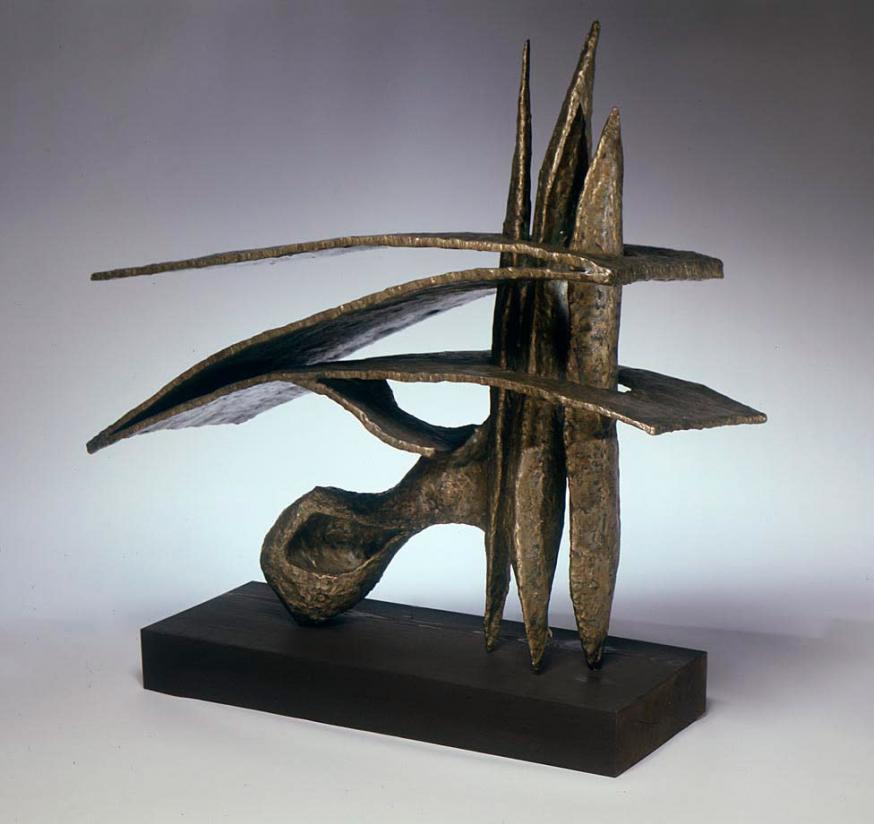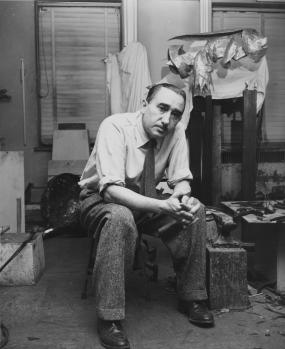Seymour Lipton
1903–1986


Seymour Lipton in his studio, New York, NY, January 1956; Photographer unknown
All artworks displayed above are currently available. To inquire about additional works available by this artist, please contact the gallery.
Biography
What we need is an art that gets unsentimentally at the core of America, its basic folk substratum. It would be commemorative of its myths; meaning would be moralistic and heroic along the mainstream of history. The heterogeneous life of American could be welded into a communal mood and direction…Such art would retain the flavor of the folk, the mood of a section, imaginatively broadened into natural and universal human significance.
Born in New York City in 1903, Seymour Lipton (1903-1986) grew up in a Bronx tenement at a time when much of the borough was still farmland. These rural surroundings enabled Lipton to explore the botanical and animal forms that would later become sources for his work. Lipton’s interest in the dialogue between artistic creation and natural phenomena was nurtured by a supportive family and cultivated through numerous visits to New York’s Museum of Natural History as well as its many botanical gardens and its zoos. In the early 1920s, with the encouragement of his family, Lipton studied electrical engineering at Brooklyn Polytechnic Institute and pursued a liberal arts education at City College. Ultimately, like fellow sculptor Herbert Ferber, Lipton became a dentist, receiving his degree from Columbia University in 1927. In the late 1920s, he began to explore sculpture, creating clay portraits of family members and friends.
In addition to providing him with financial security, dentistry gave Lipton a foundation in working with metal, a material he would later use in his artwork. In the early 1930s, though, Lipton’s primary sculptural medium was wood. Lipton led a comfortable life, but he was also aware of the economic and psychological devastation the Depression had caused New York. In response, he generally worked using direct carving techniques—a form of sculpting where the artist “finds” the sculpture within the wood in the process of carving it and without the use of models and maquettes. The immediacy of this practice enabled Lipton to create a rich, emotional and visual language with which to articulate the desperation of the downtrodden and the unwavering strength of the disenfranchised. In 1935, he exhibited one such early sculpture at the John Reed Club Gallery in New York, and three years later, ACA Gallery mounted Lipton’s first solo show, which featured these social-realist-inspired wooden works. In 1940, this largely self-taught artist began teaching sculpture at the New School for Social Research, a position he held until 1965.
In the 1940s, Lipton began to devote an increasing amount of time to his art, deviating from wood and working with brass, lead, and bronze. Choosing these metals for their visual simplicity, which he believed exemplified the universal heroism of the “everyman,” Lipton could also now explore various forms of abstraction. Lipton’s turn towards increasing abstraction in the 1940s allowed him to fully develop his metaphorical style, which in turn gave him a stronger lexicon for representing the horrors of World War II and questioning the ambiguities of human experience. He began his metal work with cast bronze sculptures, but, in 1946, he started welding sheet metal and lead. Lipton preferred welding because, as direct carving did with wood, this approach allowed “a more direct contact with the metal.”[1] From this, Lipton developed the technique he would use for the remainder of his career: “He cut sheet metal, manipulated it to the desired shapes, then joined, soldered, or welded the pieces together. Next, he brazed a metal coating to the outside to produce a uniform texture.”[2]
In 1950, Lipton arrived at his mature style of brazing on Monel metal. He also began to draw extensively, exploring the automatism that abstract expressionist painters were boasting at the time. Like contemporaries such as Jackson Pollock, Lipton was strongly influenced by Carl Jung’s work on the unconscious mind and the regenerative forces of nature. He translated these two-dimensional drawings into three-dimensional maquettes that enabled him to revise his ideas before creating the final sculpture. The forms that Lipton produced during this period were often zoomorphic, exemplifying the tension between the souls of nature and the automatism of the machine.
In the years following the 1950s, Lipton’s optimism began to rise, and the size of his work grew in proportion. The oxyacetylene torch—invented during the Second World War—allowed him to rework the surfaces of metal sculptures, thus eliminating some of the risks involved with producing large-scale finished works. In 1958, Lipton was awarded a solo exhibition at the Venice Biennale and was thus internationally recognized as part of a small group of highly regarded avant-garde constructivist sculptors. In 1960, he received a prestigious Guggenheim Award, which was followed by several prominent public commissions, including his heroic Archangel, currently residing in Lincoln Center’s David Geffen Hall.
A number of important solo exhibitions of his work followed at The Phillips Collection in Washington, DC (1964); the Milwaukee Art Center and University of Wisconsin, Milwaukee (1969); the Virginia Museum of Fine Arts in Richmond (1972); the Everson Museum in Syracuse, NY (1973); the Herbert E. Johnson Museum of Art of Cornell University in Ithaca, NY (1973); the National Collection of Fine Arts, Smithsonian Institution (now the Smithsonian American Art Museum) in Washington, DC (1978); and a retrospective in 1979 at The Jewish Museum in New York. In 1982 and 1984 alone, two exhibitions of his sculpture, organized respectively by the Mint Museum (Charlotte, NC) and the Hillwood Art Gallery of Long Island University (Greenvale, NY), traveled extensively across museums and university galleries around the nation. In 2000, the traveling exhibition An American Sculptor: Seymour Lipton was first presented by the Palmer Museum of Art of Pennsylvania State University in University Park. Most recently, in 2009, the Ackland Art Museum in Chapel Hill, NC mounted The Guardian and the Avant-Garde: Seymour Lipton’s Sentinel II in Context.
Since 2004, Michael Rosenfeld Gallery has been the exclusive representative of the Estate of Seymour Lipton and has presented two solo exhibitions of his work—Seymour Lipton: Abstract Expressionist Sculptor (2005) and Seymour Lipton: Metal (2008). In 2013, Michael Rosenfeld Gallery presented Abstract Expressionism, In Context: Seymour Lipton, which included twelve major sculptures by the artist, along with works by 20 leading American abstractionists.
Other notable group exhibitions in recent years include: Abstract Expressionist New York at the Museum of Modern Art in New York (2010); Encounters with the 1930s at the Museo Nacional Centro de Arte Reina Sofía in Madrid, Spain (2012); Its Surreal Thing: The Temptation of Objects at the Sheldon Museum of Art, University of Nebraska in Lincoln (2013); Abstraction: Drawings by Sculptors at The Metropolitan Museum of Art in New York (2015); Marvelous Objects: Surrealist Sculpture from Paris to New York at the Hirshhorn Museum and Sculpture Garden in Washington, DC (2015); Art for the Millions: American Culture and Politics in the 1930s at The Metropolitan Museum of Art (2023). In 2018, the Art Gallery of Ontario in Toronto included Lipton’s work in the reinstallation of their permanent collection, Look:Forward. In 2020, Dell Medical School at The University of Texas, Austin chose Lipton’s sculpture, Pioneer (1957), to represent its annual Ken Shine Prize in Health Leadership. Awardees, who have since included Dr. Anthony Fauci and Dr. David A. Asch, receive a small bronze reproduction of Pioneer, while the original full-scale sculpture stands in the medical school’s Health Education Building.
Seymour Lipton’s works are in numerous museum collections worldwide including the Albright-Knox Art Gallery, Buffalo, NY; Arkansas Art Center, Little Rock, AR; Art Gallery of Ontario, Toronto, Canada; Baltimore Museum of Art, Baltimore, MD; Brooklyn Museum of Art, Brooklyn, NY; Cantor Art Center, Stanford University, Palo Alto, CA; Cleveland Museum of Art, Cleveland, OH; Columbus Museum of Art, Columbus, OH; Corcoran Museum of Art, Washington, DC; Crystal Bridges Museum of Art, Bentonville, AR; Dallas Museum of Art, Dallas, TX; Delaware Art Museum, Wilmington, DE; Denver Art Museum, Denver, CO; Des Moines Art Center, Des Moines, IA; Detroit Institute of Arts, Detroit, MI; Didrichsen Museum, Helsinki, Finland; Governor Nelson A. Rockefeller Empire State Plaza Art Collection, Albany, NY; Grey Art Gallery, New York University, New York, NY; Hammer Art Museum, Los Angeles, CA; Herbert F. Johnson Museum of Art, Cornell University, Ithaca, NY; Hillwood Art Museum, Long Island University, Brookville, NY; Hirshhorn Museum and Sculpture Garden, Smithsonian Institution, Washington, DC; The Jewish Museum, New York, NY; The Metropolitan Museum of Art, New York, NY; The Mint Museum of Art, Charlotte, NC; Mobile Museum of Art, Mobile, AL; Museum of Art, Rhode Island School of Design, Providence, RI; Museum of Fine Arts, Boston, MA; The Museum of Modern Art, New York, NY; The Nelson-Atkins Museum of Art, Kansas City, MO; National Gallery of Art, Washington, DC; Neuberger Museum of Art, Purchase College, State University of New York, Purchase, NY; New Britain Museum of Art, New Britain, CT; New Orleans Museum of Art, New Orleans, LA; Newark Museum, Newark, NJ; Oklahoma City Museum of Art, Oklahoma City, OK; Pennsylvania Academy of Fine Arts, Philadelphia, PA; Philadelphia Museum of Art, Philadelphia, PA; The Phillips Collection, Washington, DC; Phoenix Art Museum, Phoenix, AZ; Portland Art Museum, Portland, OR; San Diego Museum of Art, San Diego, CA; San Francisco Museum of Modern Art, San Francisco, CA; San José Museum of Art, San José, CA; Santa Barbara Museum, Santa Barbara, CA; São Paulo Museum, São Paulo, Brazil; Smithsonian American Art Museum, Washington, DC; Tamayo Museum, Mexico City, Mexico; Tel Aviv Museum, Tel Aviv, Israel; Tucson Museum of Art, Tucson, AZ; Virginia Museum of Fine Art, Richmond, VA; Wadsworth Atheneum Museum of Art, Hartford, CT; Whitney Museum of American Art, New York, NY; Wichita Art Museum, Wichita, KS; and Yale University Art Gallery, New Haven, CT.
Michael Rosenfeld Gallery LLC has been the exclusive representative of the Estate of Seymour Lipton since 2004.
[1] Lipton as quoted in Lori Verderame, An American Sculptor: Seymour Lipton exh. cat. (University Park, PA: Palmer Museum of Art, Pennsylvania State University, 2000), 19
[2] Verderame, 19.
Gallery Exhibitions
Press
Publications

